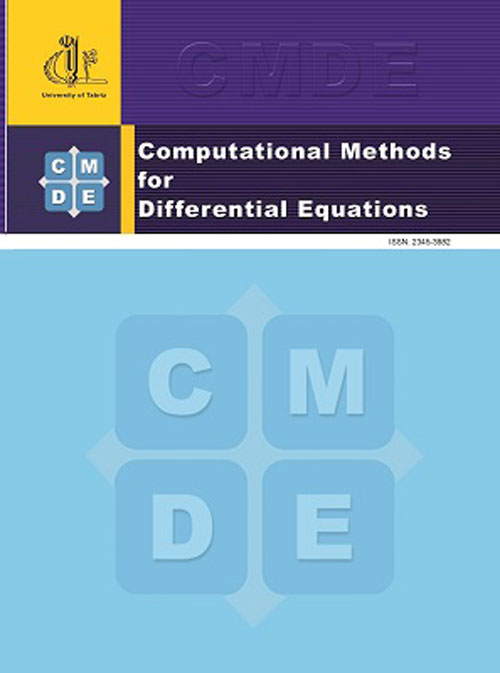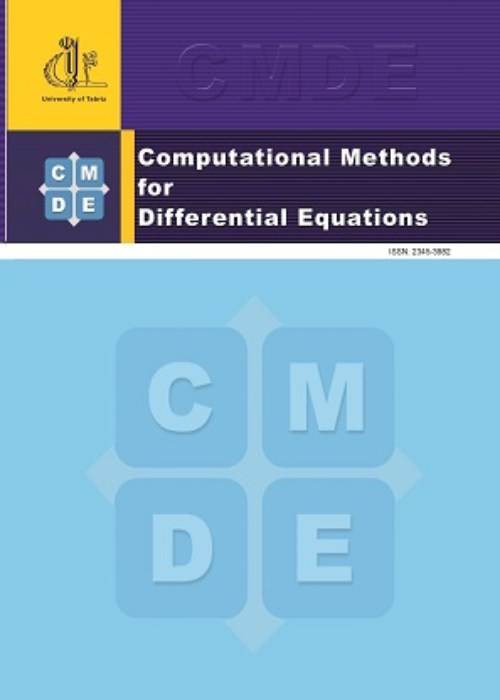فهرست مطالب

Computational Methods for Differential Equations
Volume:8 Issue: 2, Spring 2020
- تاریخ انتشار: 1399/03/11
- تعداد عناوین: 15
-
-
Pages 222-235In this paper, interval extensions of the Halley method and its modified method for finding enclosures of roots of nonlinear equations are produced. Error analysis and convergence will be discussed. Also, these methods are compared together with the interval Newton method.Keywords: Interval analysis, Nonlinear equations, Halley method, Guaranteed convergence
-
Pages 236-250We consider finite difference method to find best approximation of nonlinear singularly perturbed problem which contains multi-point boundary conditions. We surveyed the asymptotic estimates of the corresponding problem that needs to be solved with maximum principle. We constructed a finite difference scheme by using Bakhvalov mesh. Based on the error estimation, we proved that this method was first-order, uniformly convergent method with in the discrete maximum norm. Finally, we conducted a numerical experiment in order to check the theoretical resultsKeywords: Singular perturbation, finite difference scheme, Bakhvalov mesh, Uniformly convergence, multipoint boundary conditions
-
Pages 251-258This paper is concerned with the time-fractional Fornberg-Whitham equation using Lie symmetry analysis. This equation is used to describe the physical processes of models possessing memory. By employing the classical and nonclassical Lie symmetry analysis, the invariance properties of this equation are investigated. The similarity reductions and new exact solutions are obtained.Keywords: Lie symmetry analysis, Time-fractional Fornberg-Whitham equation, Group-invariant solution
-
Pages 259-267The numerous methods for solving differential equations exist, every method have benefits and drawbacks, in this field, the combined methods are very useful, one of them is the wavelet transform method (WTM). This method based on the wavelets and corresponding wavelet transform, that dependent on the differential invariants obtained by the Lie symmetry method. In this paper, we apply the WTM on the generalized version of FKPP equation (GFKPP) with non-constant coefficient futt(x,t)+ut(x,t)=uxx(x,t)+u(x,t)-u2(x,t) where f is a smooth function of either x or t. We will see for suitable wavelets, this method proposes the interesting solutions.Keywords: Wavelet, Quasi-wavelet, Mother wavelet, The wavelet transform, Differential invariants, The GFKPP equation
-
Pages 268-281In this paper, a direct method for solving Volterra-Fredholm integral equations with time delay by using orthogonal functions and their stochastic operational matrix of integration is proposed. Stochastic integral equations can be reduced to a sparse system which can be directly solved. Numerical examples show that the proposed scheme has a suitable degree of accuracy.Keywords: Delay integral equations, Stochastic operational matrix, Stochastic Volterra-Fredholm integral equations, It^o integral
-
Pages 282-293In this paper, an efficient symbolic-numerical procedure based on the power series method is presented for solving a system of differential equations. The basic idea is to substitute power series into the differential equations and to find a polynomial system of coefficients, where a powerful symbolic computation technique (i.e., Grobner basis) is used to solve the system. In fact, the proposed method is an excellent bridge between symbolic and numeric computation and specially, enables us to find the solution of linear and non-linear stiff systems. Numerical experiments were performed to justify our new approach.Keywords: Stiff initial-value problems, symbolic-numeric method, Grobner basis, Faugere's algorithm
-
Pages 294-304
In this paper, the issue of distribution of zeros of the solutions of linear homogenous differential equations (LHDE) have been investigated in terms of semi-critical intervals. We shall follow a geometric approach to state and prove some properties of LHDEs of the sixth order with (2, 3, 4, and 5 points) boundary conditions and with measurable coefficients. Moreover, the relations between semi-critical intervals of the LHDEs have been explored. Also, the obtained results have been generalized for the 5th order differential equations.
Keywords: Linear differential equations, Distribution of zeros for the solution, Boundary value problems, Semi-oscillatory interval, Semi-critical interval -
Pages 305-313In this work we constructed a numerical scheme to approximate the Volterra integro- differential equations of convolution type using Laplace transform. The solution of the problem is recovered using inverse Laplace transform as contour integral in the complex plane. The integral is then approximated along a suitable contour using the trapezoidal rule with equal step size. The solution accuracy depends on optimal contour of integrations to compute accurately the inverse Laplace transform. For better accuracy two types of contour parabolic and hyperbolic are used which are available in the literature. The performance of the numerical scheme is tested for different examples. The actual error well agree with the corresponding error estimates of the proposed numerical scheme for both parabolic as well as hyperbolic contours.Keywords: Volterra Integro-differential equation(VIDE), Hyperbolic, parabolic contours, Laplace Transforms, Trapezoidal rule
-
Pages 314-329
In this paper, one numerical method is presented for numerical approximation of linear constrained optimal control problems with quadratic performance index. The method with variable coefficients is based on Hermite polynomials. The properties of Hermite polynomials with the operational matrices of derivative are used to reduce optimal control problems to the solution of linear algebraic equations. Illustrative examples are included to demonstrate the validity and applicability of the technique.
Keywords: Optimal control, Hermite polynomials, Best approximating, Operational matrix of derivative -
Pages 330-346A nonstandard finite-difference (NSFD) scheme for Fisher’s Equation by using Richtmyer’s (3, 1, 1) implicit formula has been presented, in this work. On nonstandard finite-difference scheme, two special cases of Richtmyer formula have been applied. The suitable functions in the denominator fraction of our NSFD scheme have been replaced to guarantee the highly accurate of the approximation. Furthermore, the analyses of stability, convergence, consistency for the NSFD method, have been provided. By calculating the absolute error, the comparison of these methods has been presented in some Examples and the results have shown that the error of our NSFD scheme is lower than the others. Finally, a comparison of these methods and the differential quadrature method (DQM) to solve the Fisher’s Equation reveals that these techniques work better and give highly accurate results.Keywords: Fisher’s Equation, Nonstandard Finite-difference scheme, Consistency, Convergence, Stability
-
Pages 347-363In this paper a multiquadric quasi-interpolation (MQQI) scheme for solving the system of 1-D coupled nonlinear Burger’s equations (CNBE) is presented. The scheme utilizes the derivative of the quasi-interpolation for approximating the spatial derivative and the Taylor series expansion for temporal derivatives. Simulations are presented to demonstrate the efficiency and applicability of the scheme. Also, we have shown that our scheme is superior to some numerical schemes already done.Keywords: One dimensional coupled nonlinear Burger’s equations, Multiquadric quasi-interpolation, Compact finite difference, Collocation method
-
Pages 364-372In this paper, Lie symmetry group method is applied to study for the higher order Camassa-Holm equation. Complete analysis of symmetries and nonclassical symmetries is discussed. Furthermore, optimal system, preliminary classification of its group invariant solutions and symmetry reduction are investigated. Finally conservation laws for the higher order Camassa-Holm equation which conserved quantities arise from multipliers by using homotopy operator are presented.Keywords: Lie symmetry, Higher order Camassa-Holm equation, Optimal system, Similarity solutions, Conservation laws
-
Pages 373-388We develop a class of new methods based on modification of polynomial spline function for the numerical solution of singularly perturbed boundary-value problems. The modified spline contains the exponential terms and named by tension spline, which is infinity smooth. Tension spline contain parameter, by choosing arbitrary values of such parameters the various classes of spline can be obtained. The proposed methods are accurate for solution of linear and non-linear singularly perturbed boundary-value problems. Boundary formulas are developed to associate with spline methods. These methods are converging. The analysis of convergence is shown to yield up to O(h^8 ) approximation to the solution of singularly perturbed boundary-value problems. Comparison are carried out, numerical examples are given to showing the efficiency of our methodsKeywords: Singularly perturbed boundary-value problems, Tension spline, Boundary formula, Convergence analysis
-
Pages 389-400determination of eigenvalues and eigenfunctions of a High-order Sturm-Liouville problem (HSLP) is considered. To this end, the Differential Transformation Method (DTM) is applied which is an efficient technique for solving differential equations. The results of the proposed approach are compared with those of some well-known methods reported in the literature. Four illustrative real life examples of mechanical engineering are provided to show the ability and the cost-effectiveness of this numerical approach.Keywords: High order sturm-liouville problems, Differential transformation method, eigenvalue
-
Pages 401-407In this paper, extended trial equation method (ETEM) is applied to find exact solutions of (1+1) dimensional nonlinear Ostrovsky equation. We constitute some exact solutions such as soliton solutions, rational, Jacobi elliptic and hyperbolic function solutions of this equation via ETEM. Then, we submit the results obtained by using this method.Keywords: (1+1) dimensional nonlinear Ostrovsky equation, Extended trial equation method, Soliton solutions, Rational, Jacobi elliptic, hyperbolic function solutions


